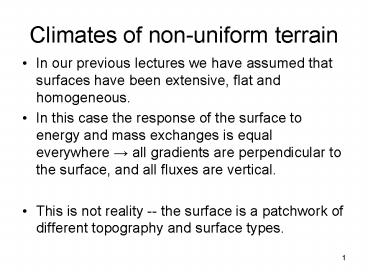Climates of nonuniform terrain - PowerPoint PPT Presentation
1 / 30
Title:
Climates of nonuniform terrain
Description:
It is not possible to separate changes in energy, mass and momentum. ... What other 'oasis effect' situations can be imagined? ... – PowerPoint PPT presentation
Number of Views:69
Avg rating:3.0/5.0
Title: Climates of nonuniform terrain
1
Climates of non-uniform terrain
- In our previous lectures we have assumed that
surfaces have been extensive, flat and
homogeneous. - In this case the response of the surface to
energy and mass exchanges is equal everywhere ?
all gradients are perpendicular to the surface,
and all fluxes are vertical. - This is not reality -- the surface is a patchwork
of different topography and surface types.
2
- This results in horizontal variations in the
available radiation and the way that the
available energy and water is partitioned giving
horizontal variations in climate. - In turn there are horizontal gradients of
properties ? horizontal fluxes will occur. - Thus we will talk about the effects of spatial
inhomogeneity and topography.
3
Spatial Heterogeneity
- There are two main cases
- 1) modification of atmospheric properties as air
moves to a different surface type (advective
effects) - and 2) circulation induced by contrasting surface
properties when regional winds are light
(thermal circulations).
4
Advective Effects
- There is a clothesline effect as flow of air
through a vegetative canopy is restricted. - As air flows from warmer, drier ground it will
increase heat supply (QH) and water vapour
gradient, such that there is enhanced
evapotranspiration. - Plants near the edge of stand will be dessicated,
buffeted by wind, and more prone to pests and so
are frequently stunted.
5
Leading Edge or Fetch Effect
- As air passes from one surface type to a new one,
it must adjust to a new set of boundary
conditions. - Only in the lower 10 of the internal boundary
layer is the air fully adjusted to the surface. - As an illustration of the way adjustment takes
place, consider the advection of moisture in the
box model - A u?V
6
Oke (1987)
7
Oke (1987)
8
- The height of the fully adjusted boundary layer
is the level at which the vertical flux equals
the surface value. - This grows slowly -- a fetch of 100-300 m for
every 1 m increase in height. - This has implications for the setting of
meteorological instruments. - There would also be differences in heat flux and
momentum transport downwind of a discontinuity.
9
Oke (1987)
10
- It is not possible to separate changes in energy,
mass and momentum. - Changes in momentum will alter K's over rough
surface and therefore enhance QH and QE.
11
Oke (1987)
12
Oasis Effect
- In hot, arid regions are areas of freely
available water. - Thus QE can exceed Q as QH due to advection of
warm air can supply extra energy ? cool
temperatures, high evaporation. - What other oasis effect situations can be
imagined? - Lake in a dry area, glacier, isolated snow patch,
urban park, isolated tree. - In each case, evaporation will be large.
13
Oke (1987)
14
Thermal Circulation Systems
- These arise because when surfaces of different
thermal environments lie next to each other,
horizontal pressure gradients develop. - Land/Sea Breezes
- These different thermal properties produce
corresponding pressure differences resulting in a
circulation that reverses at night.
15
- The daytime sea breeze has greater intensity,
depth and range (?T is greatest and instability). - The sea breeze can extend up to 30 km inland, 2-5
m s-1 in speed and circulation of 2 km in
height. - Late in the day, the Coriolis force may have an
effect so winds cross the coast at an angle. - Land breeze is generally much less intense.
16
Oke (1987)
17
- Advancing sea breeze front produces uplift, and
potentially clouds and thunderstorms (Florida is
a good example). - Lowest layer of air advected across the coastline
is modified by a leading edge effect. - A city can also generate a country breeze
because under light synoptic conditions they are
often warmer than the surrounding countryside. - However there is no diurnal reversal - city is
almost always warmer than surrounding region.
18
(No Transcript)
19
(No Transcript)
20
Effects of Topography
- First let us discuss the effect of radiation
loading. - The angle at which radiation strikes a surface is
important in determining the amount of radiation
it receives that in part determines its climate. - The effects of aspect and slope are most dramatic
at higher latitudes where the sun is at a lower
angle anyway. - South facing slopes get more radiant energy than
horizontal and north facing slopes. - Note this effect is only important for direct
beam radiation.
21
- Net radiation can be 2-4 times higher by day on a
south facing slope ? results in higher QH (if
water is limiting). - This results in distinctly different
micro-climates and vegetation.
22
(No Transcript)
23
(No Transcript)
24
Topographically-generated winds
- These arise due to thermal differences because of
slope/aspect. - Tend to occur under cloudless skies with little
or no synoptic-scale winds. - The strength and nature of flows depend on
orientation and configuration of the valley. - By day, air near valley sides will be heated more
than air at same elevation in centre of valley ?
anabatic cloud formation along ridges.
25
- This circulation warms the entire valley so that
it is warmer than neighbouring plains and an up
valley (valley wind) develops, whereas an
anti-valley wind develops above the ridges. - This system will tend to reverse at night.
26
Oke (1987)
27
Whiteman (2000)
28
Oke (1987)
29
Oke (1987)
30
Oke (1987)































